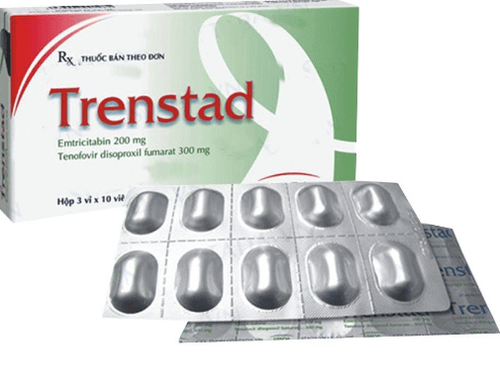This is an automatically translated article.
Tenolam drug is made in the form of film-coated tablets, with the main ingredients in each tablet including 300mg of Tenofovir disoproxil fumarate and 100mg of Lamivudin USP. So what does Tenolam do and how does it work?
1. What does Tenolam do?
Tenofovir disoproxil fumarate has the structure of a helical nucleotide diester similar to adenosine monophosphate, which is a prodrug of tenofovir. After entering the body, it is phosphorylated to the active form of diphosphate.
Tenofovir diphosphate is active against HBV polymerase and HIV reverse transcriptase. Tenofovir diphosphate inhibits viral polymerase (reverse transcriptase) by competitively binding directly to the natural substrate deoxyribonucleotide and terminating the viral DNA sequence after binding.
Lamivudine, after entering the body, is metabolized intracellularly to form triphosphate, which inhibits the synthesis of DNA of retroviruses, including HIV virus. Lamivudine is also active against hepatitis B virus.
Tenolam is indicated in the following cases:
Chronic hepatitis B in adults with compensated liver disease and evidence of viral replication and Histological evidence of active hepatitis or fibrosis. Compensated liver disease with evidence of viral replication activity, persistently elevated blood alanine aminotransferase (ALT) levels, and histological evidence of active hepatitis and/or cirrhosis . In combination with other antiretroviral drugs in the treatment of HIV . Tenolam is contraindicated in the following cases:
People with hypersensitivity to tenofovir or any other ingredient of the drug. People who are sensitive to the active ingredient Lamivudine or any of the excipients of the drug. Precautions when using Tenolam:
Monitor ALT and HBV DNA levels in the blood after stopping treatment with Tenolam. Discontinue treatment with Tenolam if lactic acidosis, severe hepatomegaly with fatty liver, and after treatment for severe hepatitis. Tenolam should not be used in patients with galactose intolerance, Lapp lactase deficiency or glucose-galactose malabsorption. Care should be taken when using Tenolam for: The elderly Patients at risk of renal dysfunction Cirrhosis Co-infection with HIV and hepatitis B Fat metabolism disorders Bone abnormalities History of joint pain and stiffness joints Difficulty moving. Treatment with Tenolam should be discontinued in patients with progressive abdominal pain, nausea, vomiting, or associated with abnormal biochemical test results until pancreatitis is ruled out. Treatment with Tenolam may be associated with lactic acidosis and treatment should be discontinued if aminotransferase levels are rapidly elevated, metabolic acidosis or lactic acidosis is unexplained, and progressive hepatomegaly. Tenolam should be used with caution in patients with hepatomegaly or other risk factors for liver disease. In patients with chronic hepatitis B who are at risk of hepatitis returning when Tenolam is discontinued, regular monitoring of liver function is required. The possibility of HIV infection should be excluded before initiating tenolam for the treatment of hepatitis B, as HIV resistance to lamivudine may be increased. It may be necessary to reduce the dose of Tenolam in patients with impaired renal function.
2. Dosage and how to take Tenolam
Tenolam is taken by mouth, the patient should take it at the same time every day.
Dosage of Tenolam drug should be according to the doctor's prescription, the reference dose is as follows:
Treatment of HIV infection: Use 1 tablet/time x 1 time/day, in combination with other antiretroviral drugs. Prevention of HIV infection: Use 1 tablet x 1 time/day in combination with other antiretroviral drugs. Prophylaxis should be initiated as soon as possible after exposure to the source of infection (preferably within hours rather than days) and continued for the next 4 weeks if tolerated. Treatment of chronic hepatitis B: Use a dose of 1 tablet x 1 time / day for more than 48 weeks. Patients with renal impairment: Tenolam dose should be reduced by adjusting the dosing interval based on the patient's creatinine clearance (Clcr): Clcr > 50 ml/min: Use the usual once daily dose. . Clcr 30 to 49 ml/min: Use every 48 hours. Clcr 10 to 29ml/min: Use every 72 to 96 hours. Patients on hemodialysis: Take each dose of Tenolam 7 days apart or 12 hours after dialysis. Patients with impaired liver function: No dose adjustment of Tenolam is necessary. Symptoms that may be encountered when using Tenolam overdose include:
Nausea, vomiting Skin rash Low blood phosphate levels Acute renal failure Lactic acidosis. Treatment of Tenolam overdose is as follows:
Symptomatic and supportive treatment. Hemodialysis can be used to remove tenofovir, lamivudine.
3. Tenolam side effects
Tenolam side effects related to Tenofovir ingredients:
Common side effects include: Diarrhea Nausea, vomiting Abdominal pain Indigestion Bloating Flatulence Loss of appetite. Increased amylase in the blood Pancreatitis. Hypophosphataemia. Skin rash. Other side effects are: Peripheral neuropathy Headache Dizziness Insomnia Depression Depression Sweating Muscle pain. Increased liver enzymes Increased blood triglycerides Increased blood sugar Decreased neutrophils. Renal failure, acute renal failure and tubular effects, including Fanconi syndrome. Tenolam side effects related to lamivudine include:
Common side effects include: Abdominal pain Nausea, vomiting Diarrhea Headache Fever Rash Hair loss Insomnia Cough Nasal symptoms Joint pain and musculoskeletal pain. Increased serum creatine phosphokinase and alanine aminotransferase enzymes are common in patients receiving lamivudine for chronic hepatitis B. Rare side effects include: Rhabdomyolysis. Pancreatitis. Neutropenia Anemia Thrombocytopenia Increased liver enzymes Hepatitis. Lactic acidosis, often accompanied by severe hepatomegaly and severe fatty liver. If you experience any side effects of Tenolam, you should immediately notify your doctor or go to the nearest medical facility for prompt medical assistance.
4. Interaction of Tenolam with other drugs
Tenolam should not be combined with: Atazanavir, Didanosine, Tracrolimus, drugs that reduce or compete with renal elimination. Patients coinfected with HIV/HBV should be combined with antiretroviral agents and an appropriate diet. Renal elimination of lamivudine in Tenolam can be inhibited by drugs that are eliminated primarily by active renal excretion, such as trimethoprim. Care should be taken when using these drugs in combination. The lamivudine in Tenolam may antagonize the antiviral effects of zalcitabine, the two drugs should not be used together. Once-daily administration of a 3-nucleoside regimen such as lamivudine and tenofovir plus abacavir or didanosine is associated with a high degree of treatment failure and the development of drug resistance, so the combination should be avoided. Tenolam is a film-coated tablet, with the main ingredient in each tablet consisting of 300mg of Tenofovir disoproxil fumarate and 100mg of Lamivudin USP. The drug is indicated for the treatment of hepatitis B and HIV. To ensure the effectiveness of treatment and avoid unwanted side effects, patients need to strictly follow the instructions of the doctor, professional pharmacist.
Follow Vinmec International General Hospital website to get more health, nutrition and beauty information to protect the health of yourself and your loved ones in your family.
Please dial HOTLINE for more information or register for an appointment HERE. Download MyVinmec app to make appointments faster and to manage your bookings easily.













